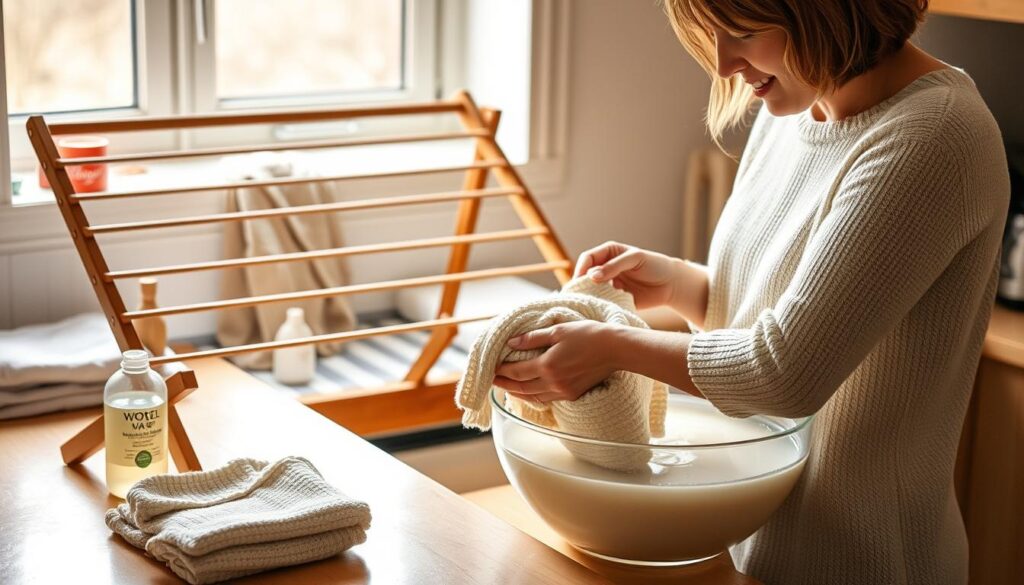Every winter, the same problem arises: that cozy sweater you loved last season now looks like it’s been shrunk in a dryer. The Right Way to Wash Sweaters & Knitwear isn’t just about keeping them clean—it’s about preserving their shape, softness, and style. Yet, many of us still end up with garments half their original size. Why? Common habits like hot water, harsh detergents, or rough drying methods silently sabotage even the sturdiest sweaters. How to Avoid Shrinking starts with understanding what your knitwear truly needs.
Natural fibers like wool or cashmere aren’t designed for regular laundry routines. Synthetic blends or cotton mixes demand different care too. Ignoring these differences turns a $50 sweater into a $50 paperweight. This guide reveals the simple steps to keep your favorites wearable season after season.
Key Takeaways
- Check care labels first to match washing methods with fabric type.
- Cold water is essential—hot water stretches fibers and causes shrinkage.
- Gentle detergents protect delicate fibers better than regular soap.
- Reshape sweaters while damp to maintain their original shape.
- Storage matters: proper folding and storage prevent creases and damage.
Understanding Fiber Types in Sweaters
Knowing your sweater’s fabric makes a big difference in Sweater Care Tips. Start by checking the label to identify wool, cashmere, cotton, or synthetic blends. Each fiber reacts uniquely to water, temperature, and cleaning methods.
Natural Fibers: Wool, Cashmere, and Cotton
Wool, like merino and lambswool, resists wrinkles but needs gentle washing. Washing Wool Sweaters Safely requires cold water and mild detergents. Cashmere, softer and lighter, traps odor and requires frequent but delicate cleaning. Cotton, though durable, can shrink if washed hot. Always air out cotton sweaters before machine washing.
Synthetic Fibers: Acrylic and Nylon
- Acrylic mimics wool but resists pilling better.
- Nylon adds stretch but melts under heat.
- Both wash well in cold water on gentle cycles.
Blends: What You Need to Know
| Fiber Mix | Key Care Note |
|---|---|
| Wool + Acrylic | Follow wool care instructions |
| Cashmere + Silk | Hand wash separately |
| Cotton + Spandex | Turn inside out before washing |
Mixed fabrics demand a middle-ground approach. Prioritize the more delicate material’s care guidelines to avoid damage.
Preparations Before Washing
Before tackling any laundry day task, proper preparation ensures your sweaters stay in top shape. Follow these Best Practices for Washing Knitwear to extend the life of your favorite knits. Start by reading care labels—these tags hold critical instructions from manufacturers.
Check Care Labels for Instructions
Look for symbols like a bucket with a hand (hand wash only) or crossed-out symbols (avoid bleach or dryers). Misreading labels can lead to irreversible damage. Always note water temperature and detergent guidelines.
Sort by Color and Fabric Type
Separate light and dark fabrics to prevent bleeding. Group similar fibers together—wool with wool, acrylic with acrylic. This step is a key Sweater Care Tip
Gather Supplies for Washing
- Mild detergent (like Woolite or The Laundress Delicate)
- Cold water in a clean sink or basin
- Mesh laundry bag (for machine washing)
- Non-abrasive towel or old bath sheet
Specialty tools like sweater blockers or pH-balanced sprays can help with specific fabrics. Never use fabric softeners—they clog fibers.
Hand Washing Method
Hand washing is the safest choice for preserving delicate knitwear’s shape and fibers. This method ensures Gentle Wash Methods for Knitwear and reduces risks of Preventing Shrinking in Sweaters. Follow these steps to maintain your sweaters’ quality.
“Hand washing extends the lifespan of cashmere and wool by avoiding harsh detergents.” – Woolite Care Guide
Why Hand Washing is Best for Delicate Knitwear
Agitation in machines stretches fibers, causing shrinkage. Hand washing lets you control water temperature and pressure. Cool water and minimal motion protect fibers, reducing shrinkage risks. This method works for 100% wool, cashmere, and blends.
Step-by-Step Hand Washing Guide
- Fill a basin with lukewarm water (below 90°F/32°C).
- Add a small amount of mild detergent (1-2 teaspoons).
- Submerge the sweater fully and let it soak 10-15 minutes.
- Press gently with palms to clean; never twist or wring.
- Drain water and repeat rinsing until soapy residue is gone.
Rinsing Your Sweaters Properly
Rinse in cool water to lock in fiber structure. Use a clean basin to avoid re-soiling. Squeeze out excess water by pressing against a towel. Never wring, as this strains seams. Proper rinsing prevents detergent residue buildup that weakens fibers.
Machine Washing Your Knitwear
When machine washing sweaters, precision matters to maintain their shape and texture. Follow these steps to balance convenience with care, ensuring The Right Way to Wash Sweaters & Knitwear keeps them in top condition.
Start by selecting the correct settings. Use a cold water cycle and the gentlest agitation option, like a delicate or wool-specific setting. Avoid high spin speeds—opt for low or no spin to reduce stretching. Keep Your Sweaters Looking New requires avoiding hot water, which can shrink fibers. Here’s how to set it up:
- Choose a cold water cycle.
- Select the delicate or handwash cycle option.
- Disable spin or set to the lowest speed available.
Place sweaters in a mesh laundry bag before starting the cycle. This barrier protects against tangles and friction from rough surfaces. Mesh bags act like a shield, preventing snagging on zippers or buttons in the machine.
Choose detergents designed for delicate fabrics. Brands like Eucalan or Woolite are gentle on natural fibers. Avoid regular laundry detergents—they contain enzymes that can degrade wool or cashmere. Use half the recommended detergent amount to prevent residue buildup.
Machine washing works for sturdy knits but always pre-test on a small area first. Zip pockets, remove accessories, and never overload the machine. Prioritize hand washing for highly delicate items, but when using a machine, these steps ensure long-term durability.
Drying Techniques for Sweaters
Proper drying is crucial to How to Avoid Shrinking and maintaining sweater shape. Follow these steps to keep your knitwear looking new:
Never Hang Dry: The Right Way to Lay Flat
Hang drying stretches fibers, causing distortion. Lay sweaters flat on a clean towel. Roll excess water gently before placing them on a dry surface. Reshape collars and sleeves to original dimensions while damp.
- Use a towel large enough to fully support the garment
- Place on a flat surface away from heat sources
- Avoid folding until completely dry
Avoiding Direct Sunlight and Heat
Heat from dryers, radiators, or sunlight triggers fiber contraction, leading to Preventing Shrinking in Sweaters. Dry sweaters in a cool, shaded area. Air-dry indoors in well-ventilated spaces. Never use heat settings in dryers—even for synthetic blends.
Tips for Reshaping Your Sweaters
After laying flat, gently stretch wool or cashmere sweaters to their labeled measurements while damp. For acrylic blends, press out excess water without twisting. Block oversized sweaters by pinning edges to foam boards to maintain shape during drying.
Following these steps ensures fibers retain their structure, preserving both size and texture. Proper drying complements washing methods to extend garment lifespan effectively.
Storing Sweaters Properly
Proper storage ensures your knitwear stays in pristine condition between uses. Follow these strategies to extend their lifespan and maintain their shape and texture.

Folding vs. Hanging: What Works Best
Most sweaters should be folded, not hung, to avoid stretching. Place them flat on a surface, fold in thirds lengthwise, then fold into thirds again. Bulky knits or sweaters with embellishments should never hang, as this strains seams. For delicate items, use acid-free tissue paper between layers to prevent creasing.
Seasonal Storage Tips
- Clean garments before storing—dirt attracts pests and stains set over time.
- Use breathable containers like cotton garment bags or mesh bins instead of plastic.
- Add cedar blocks or lavender sachets to repel moths without chemical sprays.
- Store in cool, dry spaces like closets or under-bed bins—avoid attics or basements prone to humidity.
Maintaining Shape During Storage
For bulky sweaters, stuff the sleeves with acid-free tissue to retain their shape. Stack folded items horizontally, not vertically, to prevent bottom layers from becoming misshapen. Rotate seasonal pieces yearly to ensure even wear and airflow.
Following these Sweater Care Tips ensures your knitwear remains as soft and stylish as the day you bought them, helping you Keep Your Sweaters Looking New for years to come.
Common Mistakes to Avoid
Protect your knitwear investments by avoiding these three pitfalls. Best Practices for Washing Knitwear require vigilance against habits that undo even the most careful care routines.
Washing with Hot Water
High temperatures trigger irreversible How to Avoid Shrinking by denaturing protein fibers like wool and cashmere. Use this guide:
| Fiber Type | Max Safe Temp (°F) |
|---|---|
| Wool | 85°F |
| Cashmere | 75°F |
| Cotton | 105°F |
Neglecting Pockets and Zippers
Before washing:
- Empty all pockets
- Zip zippers completely
- Button all closures
Zippers act like steel wool against delicate fibers—always secure before handling.
Using Too Much Detergent
Follow this Best Practices for Washing Knitwear guide:
- Use 1 tsp liquid detergent per gallon of water
- Double-check detergent caps’ measurement lines
- Rinse thoroughly until suds disappear
Residual detergent build-up weakens fibers over time.
Tips for Dealing with Shrinkage

Even with proper care, knitwear can shrink. Here’s how to repair damage and avoid future issues.
How to Stretch a Shrunken Sweater
For wool or cashmere, soak the garment in lukewarm water mixed with a quarter-cup of hair conditioner for 30 minutes. Gently stretch to the original size while damp, reshaping seams and sleeves. Avoid over-stretching, as fibers may break. Lay flat to dry on a towel.
Prevention Techniques for Future Washing
Enhance protection for delicate items using these methods:
- Use wool washes like Eucalan or Woolite, which are dye-free and pH balanced.
- Soak in cold water with a few drops of fabric softener before washing.
- After drying, store on padded hangers to retain shape.
| Method | Benefit |
|---|---|
| Wool washes | Preserves fiber elasticity |
| Cold-water soaks | Avoids heat-related shrinkage |
When to Seek Professional Cleaning Services
Consult professionals for:
- Sweaters worth $100+
- Hand-knit or vintage pieces
- Delicate lace or cable-knit designs
Check for “dry clean only” tags or consult experts if unsure.
Caring for Knitwear Beyond Washing
Maintaining your sweaters’ appearance and durability relies on consistent care beyond routine washing. Adopt these practices to extend the lifespan of your favorite knits and ensure they stay in top condition.
Regular Maintenance: Pilling and Stains
Combat fabric pills using tools like the Rowenta Fabric Shaver or a manual sweater comb. For stains, act quickly with products like Shout or OxiClean Stain Remover. Gently brush wool fibers weekly to restore texture and prevent matting.
The Importance of Timely Repairs
Fix minor issues immediately—secure loose threads with a needle or take garments to a tailor for larger tears. For delicate fabrics, consider professional services like The Laundress for precision repairs. Small fixes prevent major damage over time.
Seasonal Care: Keeping Colors Vibrant
Rotate frequently worn sweaters and store them in breathable cotton bags away from sunlight. Use color-safe detergents like Woolite and rinse with vinegar for stubborn stains. Air out garments monthly to refresh without washing.
Combining these steps with the right way to wash sweaters & knitwear ensures long-term quality. Consistent care keeps fibers resilient and colors bright, helping your sweaters stay stylish and functional season after season. Proper maintenance turns occasional washing into a strategy for lasting style.

